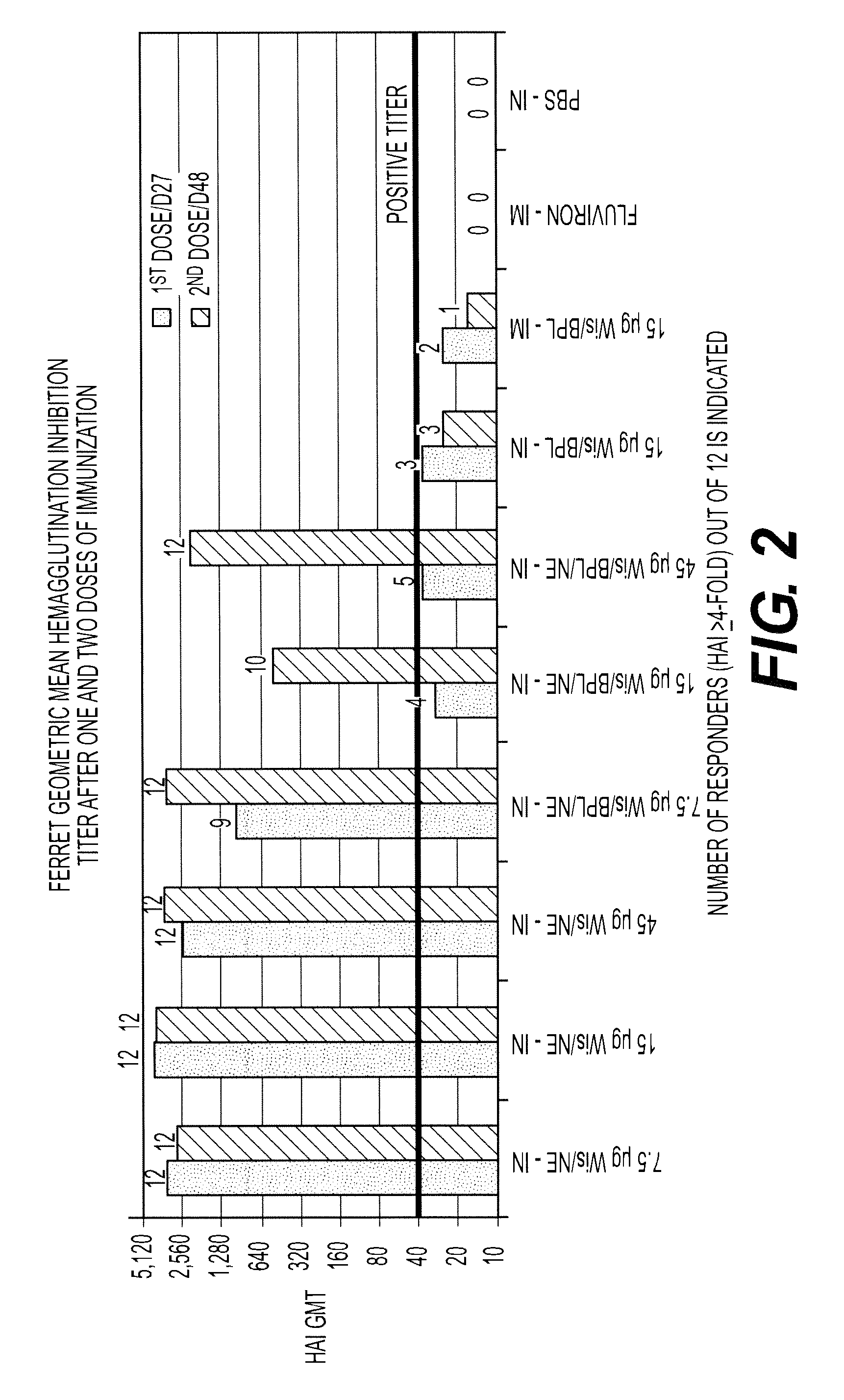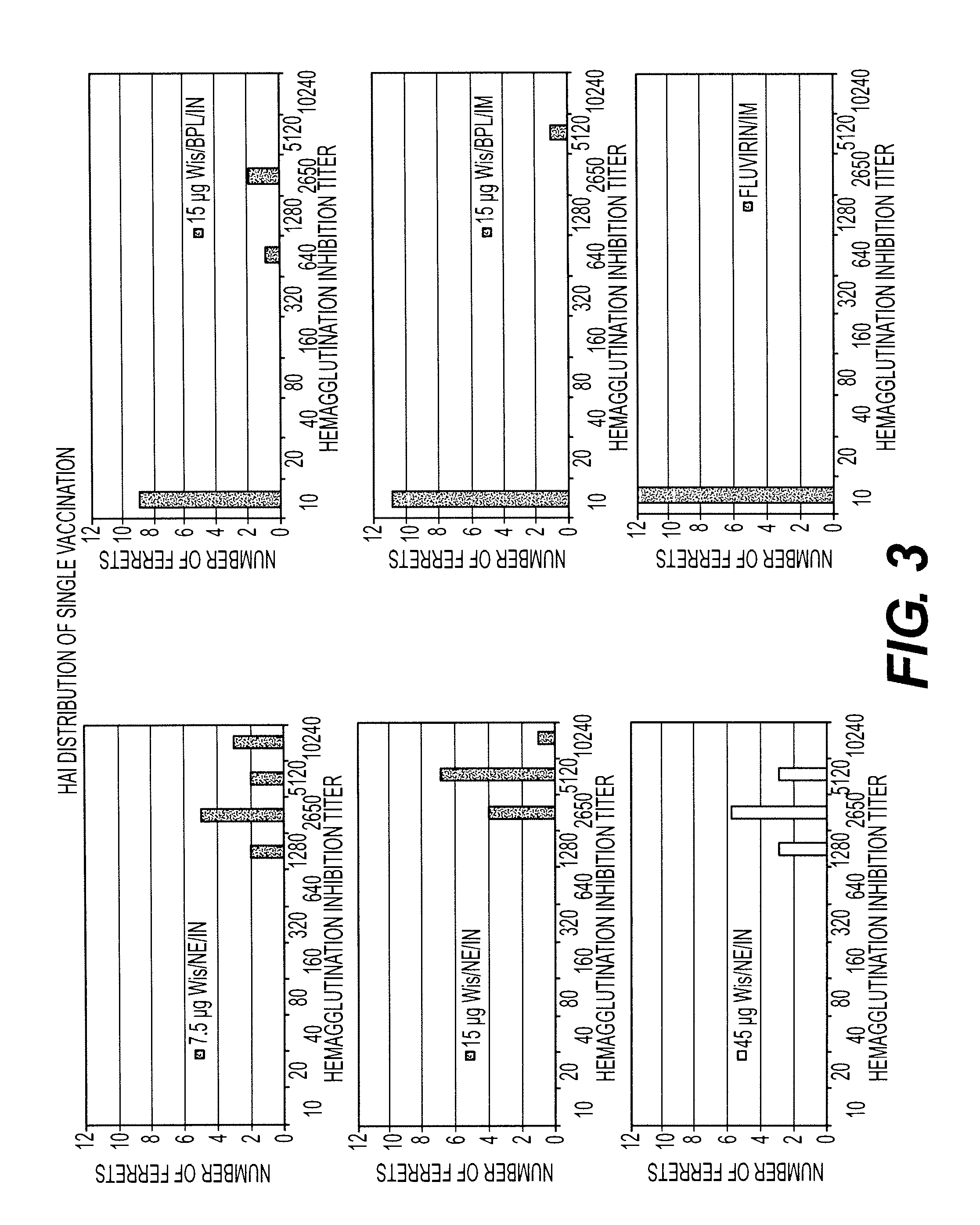Nanoemulsion influenza vaccine
a technology of influenza vaccine and emulsion, which is applied in the direction of immunological disorders, antibody medical ingredients, peptide sources, etc., can solve the problems of difficult to develop a vaccine, serious public health threat, and death of hundreds of thousands of peopl
- Summary
- Abstract
- Description
- Claims
- Application Information
AI Technical Summary
Benefits of technology
Problems solved by technology
Method used
Image
Examples
example 1
Virus Inactivation
[0223]1.1 Virus Preparation
[0224]Influenza H3N2 Strain A / Wisconsin / 67 / 2005 was obtained from the Centers for Disease Control. The virus was propagated in the allantoic cavity of 10 day embryonic hens' eggs according to standard procedures. The allantoic fluid was clarified by low speed centrifugation. The influenza virus was concentrated from the low speed supernatant by high speed centrifugation and purified using a sucrose gradient.
[0225]1.2 Virus Inactivation
[0226]To compare the effectiveness of inactivation of influenza by nanoemulsion compositions with the standard method of β-propiolactone (βPL) inactivation, virus generated in Section 1.1 was treated as follows.
[0227]The nanoemulsion (NE) composition was formulated according to Table 3.
TABLE 3Nanoemulsion compositionComponentConcentration v / vWater84.7%Soybean Oil12.6%Ethanol1.35%Polysorbate 801.18%Cetylpyridinium chloride (CPC)0.2%
[0228]Method of Nanoemulsion Inactivation: For inactivation, the virus was inc...
example 2
Efficacy of Nanoemulsion Influenza Vaccine in Animal Model
[0231]The goal of this study was to ascertain the efficacy of vaccine with nanoemulsion to protect against subsequent infection by H3N2 virus in a ferret model.
Ferret Study #1
[0232]Ferret study #1 was an investigation to evaluate the adjuvant properties of the W805EC-adjuvant with whole influenza virus inactivated by various methods.
[0233]2.1 Animals:
[0234]Approximately 5-to 8-month-old, influenza naive, castrated and descented, male Fitch ferrets (Mustela putorius furo) were used in this study.
[0235]Ferret prebleed serum was tested for the presence of hemagglutination inhibiting (HAI) antibodies to currently circulating human influenza viruses using HAI assay. Animals demonstrating an HAI titer of >10 hemagglutination units (HAU) were excluded from the study. Animals were quarantined in an ABSL-3 (Animal biosafety level) facility for a period of at least 4-7 days. During the quarantine period animals were assessed for gener...
example 3
Efficacy of Nanoemulsion Influenza Vaccine in Animal Model
[0271]The goal of this study was to ascertain if the efficacy of commercial seasonal influenza vaccines with nanoemulsion adjuvant protects against subsequent infection by H3N2 in a ferret model.
Ferret Study #2
[0272]Ferret study #2 was designed to examine immune responses to increasing total HA antigen doses of 7.5, 22.5 and 36 μg mixed with 20% W805EC after one and two doses. HAI titers to A / Wisconsin (H3N2), A / Solomon Islands (H1N1) and B / Malaysia contained in the commercial Fluvirin® and Fluzone® (2007-2008) vaccines were evaluated (Table 6).
TABLE 6Ferret Study #2: Design# Ferrets / Arm45 μg total36 μg total22.5 μg7.5 μg totalVaccineRouteHAHAtotal HAHAFluvirin ® +IN9101020% W805ECFluvirin ®IN9Fluvirin ®IM9Fluzone ® +IN10101020% W805ECFluzone ®IN9Fluzone ®IM9PBS controlIN9
[0273]3.1 Animals:
[0274]The ferrets were prepared and handled according to essentially the same protocol as described in Example 2, section 2.1.
[0275]3.2 T...
PUM
| Property | Measurement | Unit |
|---|---|---|
| Temperature | aaaaa | aaaaa |
| Temperature | aaaaa | aaaaa |
| Temperature | aaaaa | aaaaa |
Abstract
Description
Claims
Application Information
 Login to View More
Login to View More - R&D
- Intellectual Property
- Life Sciences
- Materials
- Tech Scout
- Unparalleled Data Quality
- Higher Quality Content
- 60% Fewer Hallucinations
Browse by: Latest US Patents, China's latest patents, Technical Efficacy Thesaurus, Application Domain, Technology Topic, Popular Technical Reports.
© 2025 PatSnap. All rights reserved.Legal|Privacy policy|Modern Slavery Act Transparency Statement|Sitemap|About US| Contact US: help@patsnap.com



